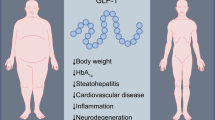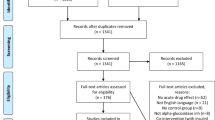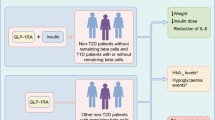Abstract
Qualitative and quantitatively appropriate insulin secretion is essential for optimal control of blood glucose. Beta-cells of the pancreas produce and secrete insulin in response to glucose and non-glucose stimuli including amino acids. In this manuscript, we review the literature on amino acid-stimulated insulin secretion in oral and intravenous in vivo studies, in addition to the in vitro literature, and describe areas of consensus and gaps in understanding. We find promising evidence that the synergism of amino acid-stimulated insulin secretion could be exploited to develop novel therapeutics, but that a systematic approach to investigating these lines of evidence is lacking. We highlight evidence that supports the relative preservation of amino acid-stimulated insulin secretion compared to glucose-stimulated insulin secretion in type 2 diabetes, and make the case for the therapeutic potential of amino acids. Finally, we make recommendations for research and describe the potential clinical utility of nutrient-based treatments for type 2 diabetes including remission services.

Similar content being viewed by others
Data availability
N/A as we did not collect any primary data for this manuscript.
References
Anello M, Ucciardello V, Piro S, Patané G, Frittitta L, Calabrese V, Giuffrida Stella AM, Vigneri R, Purrello F, Rabuazzo AM (2001) Chronic exposure to high leucine impairs glucose-induced insulin release by lowering the ATP-to-ADP ratio. Am J Physiol Endocrinol Metab 281(5):E1082–E1087
Berger S, Vongaraya N (1966) Insulin response to ingested protein in diabetes. Diabetes 15(5):303–306
Blachier F, Boutry C, Bos C, Tomé D (2009) Metabolism and functions of L-glutamate in the epithelial cells of the small and large intestines. Am J Clin Nutr 90(3):814s–821s
Bolea S, Pertusa JA, Martín F, Sanchez-Andrés JV, Soria B (1997) Regulation of pancreatic beta-cell electrical activity and insulin release by physiological amino acid concentrations. Pflugers Arch 433(6):699–704
Bränström R, Efendić S, Berggren PO, Larsson O (1998) Direct inhibition of the pancreatic beta-cell ATP-regulated potassium channel by alpha-ketoisocaproate. J Biol Chem 273(23):14113–14118
Brennan L, Shine A, Hewage C, Malthouse JPG, Brindle KM, McClenaghan N, Flatt PR, Newsholme P (2002) A nuclear magnetic resonance-based demonstration of substantial oxidative l-alanine metabolism and l-alanine-enhanced glucose metabolism in a clonal pancreatic β-cell line: metabolism of l-alanine is important to the regulation of insulin secretion. Diabetes 51(6):1714–1721
Casperson SL, Sheffield-Moore M, Hewlings SJ, Paddon-Jones D (2012) Leucine supplementation chronically improves muscle protein synthesis in older adults consuming the RDA for protein. Clin Nutr 31(4):512–519
Cen J, Sargsyan E, Bergsten P (2016) Fatty acids stimulate insulin secretion from human pancreatic islets at fasting glucose concentrations via mitochondria-dependent and -independent mechanisms. Nutr Metab 13(1):59
Corless M, Kiely A, McClenaghan NH, Flatt PR, Newsholme P (2006) Glutamine regulates expression of key transcription factor, signal transduction, metabolic gene, and protein expression in a clonal pancreatic beta-cell line. J Endocrinol 190(3):719–727
Dawson-Hughes B, Harris SS, Rasmussen HM, Dallal GE (2007) Comparative effects of oral aromatic and branched-chain amino acids on urine calcium excretion in humans. Osteoporos Int 18(7):955–961
Del Prato S, Tiengo A (2001) The importance of first-phase insulin secretion: implications for the therapy of type 2 diabetes mellitus. Diabetes Metab Res Rev 17(3):164–174
Del Prato S, Leonetti F, Simonson DC, Sheehan P, Matsuda M, DeFronzo RA (1994) Effect of sustained physiologic hyperinsulinaemia and hyperglycaemia on insulin secretion and insulin sensitivity in man. Diabetologia 37(10):1025–1035
Dunne MJ, Yule DI, Gallacher DV, Petersen OH (1990) Effects of alanine on insulin-secreting cells: patch-clamp and single cell intracellular Ca2+ measurements. Biochim Biophys Acta 1055(2):157–164
Efendić S, Lins PE, Cerasi E (1979) Potentiation and inhibition of insulin release in man following priming with glucose and with arginine–effect of somatostatin. Acta Endocrinol (Copenh) 90(2):259–271
Fasching P, Ratheiser K, Nowotny P, Uurzemann S, Parzer S, Waldhäusl W (1994) Insulin production following intravenous glucose, arginine, and valine: different pattern in patients with impaired glucose tolerance and non-insulin-dependent diabetes mellitus. Metabolism 43(3):385–389
Fitch WL, King JC (1987) Plasma amino acid, glucose, and insulin responses to moderate-protein and high-protein test meals in pregnant, nonpregnant, and gestational diabetic women. Am J Clin Nutr 46(2):243–249
Floyd JC Jr, Fajans SS, Conn JW, Knopf RF, Rull J (1966) Stimulation of insulin secretion by amino acids. J Clin Invest 45(9):1487–1502
Floyd JC Jr, Fajans SS, Pek S, Thiffault CA, Knopf RF, Conn JW (1970) Synergistic effect of certain amino acid pairs upon insulin secretion in man. Diabetes 19(2):102–108
Gannon MC, Nuttall FQ (2010) Amino acid ingestion and glucose metabolism–a review. IUBMB Life 62(9):660–668
Gannon MC, Nuttall JA, Damberg G, Gupta V, Nuttall FQ (2001) Effect of protein ingestion on the glucose appearance rate in people with type 2 diabetes. J Clin Endocrinol Metab 86(3):1040–1047
Gannon MC, Hoover H, Nuttall FQ (2010) Further decrease in glycated hemoglobin following ingestion of a LoBAG30 diet for 10 weeks compared to 5 weeks in people with untreated type 2 diabetes. Nutr Metab (lond) 7:64
Gerst F, Singer C, Noack K, Graf D, Kaiser G, Panse M, Kovarova M, Schleicher E, Häring HU, Drews G, Ullrich S (2019) Glucose responsiveness of β-cells depends on fatty acids. Exp Clin Endocrinol Diabetes 128(10):644–653
Gleason CE, Gonzalez M, Harmon JS, Robertson RP (2000) Determinants of glucose toxicity and its reversibility in the pancreatic islet beta-cell line, HIT-T15. Am J Physiol Endocrinol Metab 279(5):E997–E1002
Güttler F, Kühl C, Pedersen L, Påby P (1978) Effects of oral phenylalanine load on plasma glucagon, insulin, amino acid and glucose concentrations in man. Scand J Clin Lab Invest 38(3):255–260
Gylfe E (1976) Comparison of the effects of leucines, non-metabolizable leucine analogues and other insulin secretagogues on the activity of glutamate dehydrogenase. Acta Diabetol Lat 13(1–2):20–24
Han G, Takahashi H, Murao N, Gheni G, Yokoi N, Hamamoto Y, Asahara SI, Seino Y, Kido Y, Seino S (2021) Glutamate is an essential mediator in glutamine-amplified insulin secretion. J Diabetes Investig 12(6):920–930
Helman A, Cangelosi AL, Davis JC, Pham Q, Rothman A, Faust AL, Straubhaar JR, Sabatini DM, Melton DA (2020) A nutrient-sensing transition at birth triggers glucose-responsive insulin secretion. Cell Metab 31(5):1004–1016
Henquin JC, Meissner HP (1981) Effects of amino acids on membrane potential and 86Rb+ fluxes in pancreatic beta-cells. Am J Physiol 240(3):E245–E252
Hermans MP, Schmeer W, Henquin JC (1987) The permissive effect of glucose, tolbutamide and high K+ on arginine stimulation of insulin release in isolated mouse islets. Diabetologia 30(8):659–665
Holm LJ, Haupt-Jorgensen M, Larsen J, Giacobini JD, Bilgin M, Buschard K (2018) L-serine supplementation lowers diabetes incidence and improves blood glucose homeostasis in NOD mice. PLoS ONE 13(3):e0194414
Imanzadeh H, Sefid-Sefidehkhan Y, Afshary H, Afruz A, Amiri M (2023) Nanomaterial-based electrochemical sensors for detection of amino acids. J Pharm Biomed Anal 230:115390
Karusheva Y, Koessler T, Strassburger K, Markgraf D, Mastrototaro L, Jelenik T, Simon MC, Pesta D, Zaharia OP, Bodis K, Barenz F, Schmoll D, Wolkersdorfer M, Tura A, Pacini G, Burkart V, Mussig K, Szendroedi J, Roden M (2019) Short-term dietary reduction of branched-chain amino acids reduces meal-induced insulin secretion and modifies microbiome composition in type 2 diabetes: a randomized controlled crossover trial. Am J Clin Nutr 110(5):1098–1107
Kolic J, Sun WG, Cen H, Ewald J, Beet L, Moravcova R, Rogalski JC, Sasaki S, Sun H, Rajesh V, Xia YH, Skovsø S, Spigelman AF, Fox JEM, Lyon J, Xia J, Lynn FC, Gloyn AL, Foster LJ, MacDonald PE, Johnson JD (2023) Proteomic predictors of individualized nutrient-specific insulin secretion in health and disease. medRxiv. https://doi.org/10.1101/2023.05.24.23290298
Kouw IW, Gorissen SH, Burd NA, Cermak NM, Gijsen AP, van Kranenburg J, van Loon LJ (2015) Postprandial protein handling is not impaired in type 2 diabetes patients when compared with normoglycemic controls. J Clin Endocrinol Metab 100(8):3103–3111
Lean ME, Leslie WS, Barnes AC, Brosnahan N, Thom G, McCombie L, Peters C, Zhyzhneuskaya S, Al-Mrabeh A, Hollingsworth KG, Rodrigues AM, Rehackova L, Adamson AJ, Sniehotta FF, Mathers JC, Ross HM, McIlvenna Y, Stefanetti R, Trenell M, Welsh P, Kean S, Ford I, McConnachie A, Sattar N, Taylor R (2018) Primary care-led weight management for remission of type 2 diabetes (DiRECT): an open-label, cluster-randomised trial. Lancet 391(10120):541–551
Lean MEJ, Leslie WS, Barnes AC, Brosnahan N, Thom G, McCombie L, Peters C, Zhyzhneuskaya S, Al-Mrabeh A, Hollingsworth KG, Rodrigues AM, Rehackova L, Adamson AJ, Sniehotta FF, Mathers JC, Ross HM, McIlvenna Y, Welsh P, Kean S, Ford I, McConnachie A, Messow CM, Sattar N, Taylor R (2019) Durability of a primary care-led weight-management intervention for remission of type 2 diabetes: 2-year results of the DiRECT open-label, cluster-randomised trial. Lancet Diabetes Endocrinol 7(5):344–355
Leenders M, Verdijk LB, van der Hoeven L, van Kranenburg J, Hartgens F, Wodzig WK, Saris WH, van Loon LJ (2011) Prolonged leucine supplementation does not augment muscle mass or affect glycemic control in elderly type 2 diabetic men. J Nutr 141(6):1070–1076
Lindgren O, Pacini G, Tura A, Holst JJ, Deacon CF, Ahren B (2015) Incretin effect after oral amino acid ingestion in humans. J Clin Endocrinol Metab 100(3):1172–1176
Liu Z, Jeppesen PB, Gregersen S, Chen X, Hermansen K (2008) Dose- and glucose-dependent effects of amino acids on insulin secretion from isolated mouse islets and clonal INS-1E beta-cells. Rev Diabet Stud 5(4):232–244
Liu Z, Jeppesen PB, Gregersen S, Larsen LB, Hermansen K (2012) Chronic exposure to leucine in vitro induces β-cell dysfunction in INS-1E cells and mouse islets. J Endocrinol 215(1):79–88
Malaisse WJ, Hutton JC, Carpinelli AR, Herchuelz A, Sener A (1980) The stimulus-secretion coupling of amino acid-induced insulin release: metabolism and cationic effects of leucine. Diabetes 29(6):431–437
Malaisse-Lagae F, Welsh M, Lebrun P, Herchuelz A, Sener A, Hellerström C, Malaisse WJ (1984) The stimulus-secretion coupling of amino acid-induced insulin release. Secretory and oxidative response of pancreatic islets to L-asparagine. Diabetes 33(5):464–469
Manders RJ, Wagenmakers AJ, Koopman R, Zorenc AH, Menheere PP, Schaper NC, Saris WH, van Loon LJ (2005) Co-ingestion of a protein hydrolysate and amino acid mixture with carbohydrate improves plasma glucose disposal in patients with type 2 diabetes. Am J Clin Nutr 82(1):76–83
Manders RJ, Koopman R, Sluijsmans WE, van den Berg R, Verbeek K, Saris WH, Wagenmakers AJ, van Loon LJ (2006) Co-ingestion of a protein hydrolysate with or without additional leucine effectively reduces postprandial blood glucose excursions in Type 2 diabetic men. J Nutr 136(5):1294–1299
Manders RJ, Hansen D, Zorenc AH, Dendale P, Kloek J, Saris WH, van Loon LJ (2014) Protein co-ingestion strongly increases postprandial insulin secretion in type 2 diabetes patients. J Med Food 17(7):758–763
McClenaghan NH, Barnett CR, O’Harte FP, Flatt PR (1996) Mechanisms of amino acid-induced insulin secretion from the glucose-responsive BRIN-BD11 pancreatic B-cell line. J Endocrinol 151(3):349–357
McClenaghan NH, Barnett CR, Flatt PR (1998) Na+ cotransport by metabolizable and nonmetabolizable amino acids stimulates a glucose-regulated insulin-secretory response. Biochem Biophys Res Commun 249(2):299–303
McClenaghan NH, Scullion SM, Mion B, Hewage C, Malthouse JP, Flatt PR, Newsholme P, Brennan L (2009) Prolonged L-alanine exposure induces changes in metabolism, Ca(2+) handling and desensitization of insulin secretion in clonal pancreatic beta-cells. Clin Sci (lond) 116(4):341–351
Modi H, Cornu M, Thorens B (2014) Glutamine stimulates biosynthesis and secretion of insulin-like growth factor 2 (IGF2), an autocrine regulator of beta cell mass and function. J Biol Chem 289(46):31972–31982
Mullooly N, Vernon W, Smith DM, Newsholme P (2014) Elevated levels of branched-chain amino acids have little effect on pancreatic islet cells, but L-arginine impairs function through activation of the endoplasmic reticulum stress response. Exp Physiol 99(3):538–551
Newsholme P, Bender K, Kiely A, Brennan L (2007) Amino acid metabolism, insulin secretion and diabetes. Biochem Soc Trans 35(Pt 5):1180–1186
Newsholme P, Gaudel C, McClenaghan NH (2010) Nutrient regulation of insulin secretion and beta-cell functional integrity. Adv Exp Med Biol 654:91–114
Newsholme P, Cruzat V, Arfuso F, Keane K (2014) Nutrient regulation of insulin secretion and action. J Endocrinol 221(3):R105–R120
Noguchi GM, Huising MO (2019) Integrating the inputs that shape pancreatic islet hormone release. Nat Metab 1(12):1189–1201
Pacini G, Ahrén B, Göbl C, Tura A (2022) Assessing the effect of incretin hormones and other insulin secretagogues on pancreatic beta-cell function: review on mathematical modelling approaches. Biomedicines 10(5):1060
Paterson KR, Gyi KM, McBride D, Cohen HN, Shenkin A, Manderson WG, MacCuish AC (1985) Effect of sulphonyl urea administration on insulin secretion and amino acid metabolism in non-insulin-dependent diabetic patients. Diabet Med 2(1):38–40
Pedersen MG, Tagliavini A, Henquin JC (2019) Calcium signaling and secretory granule pool dynamics underlie biphasic insulin secretion and its amplification by glucose: experiments and modeling. Am J Physiol Endocrinol Metab 316(3):E475–E486
Rorsman P, Ashcroft FM (2018) Pancreatic β-cell electrical activity and insulin secretion: of mice and men. Physiol Rev 98(1):117–214
Rorsman P, Braun M (2013) Regulation of insulin secretion in human pancreatic islets. Annu Rev Physiol 75:155–179
Savage PJ, Bennion LJ, Flock EV, Bennett PH (1979) Beta cell dysfunction in maturity-onset diabetes: reversible loss of glucose-induced insulin secretion with retention of response to arginine. Adv Exp Med Biol 119:219–225
Schmid R, Schusdziarra V, Schulte-Frohlinde E, Maier V, Classen M (1989) Role of amino acids in stimulation of postprandial insulin, glucagon, and pancreatic polypeptide in humans. Pancreas 4(3):305–314
Sener A, Somers G, Devis G, Malaisse WJ (1981) The stimulus-secretion coupling of amino acid-induced insulin release. Biosynthetic and secretory responses of rat pancreatic islet to L-leucine and L-glutamine. Diabetologia 21(2):135–142
Skytte MJ, Samkani A, Petersen AD, Thomsen MN, Astrup A, Chabanova E, Frystyk J, Holst JJ, Thomsen HS, Madsbad S, Larsen TM, Haugaard SB, Krarup T (2019) A carbohydrate-reduced high-protein diet improves HbA(1c) and liver fat content in weight stable participants with type 2 diabetes: a randomised controlled trial. Diabetologia 62(11):2066–2078
Skytte MJ, Samkani A, Astrup A, Frystyk J, Rehfeld JF, Holst JJ, Madsbad S, Burling K, Fenger M, Thomsen MN (2020) Effects of carbohydrate restriction on postprandial glucose metabolism, beta-cell function, gut hormone secretion, and satiety in patients with type 2 diabetes. Am J Physiol Endocrinol Metab 320:E7–E18
Sloun BV, Goossens GH, Erdos B, Lenz M, Riel NV, Arts ICW (2020) The impact of amino acids on postprandial glucose and insulin kinetics in humans: a quantitative overview. Nutrients 12(10):3211
Steven S, Hollingsworth KG, Al-Mrabeh A, Avery L, Aribisala B, Caslake M, Taylor R (2016) Very low-calorie diet and 6 months of weight stability in type 2 diabetes: pathophysiological changes in responders and nonresponders. Diabetes Care 39(5):808–815
Taylor R, Al-Mrabeh A, Zhyzhneuskaya S, Peters C, Barnes AC, Aribisala BS, Hollingsworth KG, Mathers JC, Sattar N, Lean MEJ (2018) Remission of human type 2 diabetes requires decrease in liver and pancreas fat content but is dependent upon capacity for beta cell recovery. Cell Metab 28(4):547-556.e543
Thomsen SK, Gloyn AL (2014) The pancreatic β cell: recent insights from human genetics. Trends Endocrinol Metab 25(8):425–434
Totzauer M, Escribano J, Closa-Monasterolo R, Luque V, Verduci E, ReDionigi A, Langhendries JP, Martin F, Xhonneux A, Gruszfeld D, Socha P, Grote V, Koletzko B (2022) Different protein intake in the first year and its effects on adiposity rebound and obesity throughout childhood: 11 years follow-up of a randomized controlled trial. Pediatr Obes 17(12):e12961
Tremblay F, Krebs M, Dombrowski L, Brehm A, Bernroider E, Roth E, Nowotny P, Waldhäusl W, Marette A, Roden M (2005) Overactivation of S6 kinase 1 as a cause of human insulin resistance during increased amino acid availability. Diabetes 54(9):2674–2684
Turbitt J, Brennan L, Moffett RC, Flatt PR, Johnson PRV, Tarasov AI, McClenaghan NH (2023) NKCC transport mediates the insulinotropic effects of taurine and other small neutral amino acids. Life Sci 316:121402
van Loon LJ, Kruijshoop M, Verhagen H, Saris WH, Wagenmakers AJ (2000) Ingestion of protein hydrolysate and amino acid-carbohydrate mixtures increases postexercise plasma insulin responses in men. J Nutr 130(10):2508–2513
van Loon LJ, Kruijshoop M, Menheere PP, Wagenmakers AJ, Saris WH, Keizer HA (2003) Amino acid ingestion strongly enhances insulin secretion in patients with long-term type 2 diabetes. Diabetes Care 26(3):625–630
Wang H, Kuang J, Xu M, Gao Z, Li Q, Liu S, Zhang F, Yu Y, Liang Z, Zhao W, Yang G, Li L, Wang Y, Li G (2019) Predictors of long-term glycemic remission after 2-week intensive insulin treatment in newly diagnosed type 2 diabetes. J Clin Endocrinol Metab 104(6):2153–2162
Welsh M, Sener A, Malaisse-Lagae F, Malaisse WJ (1984) The stimulus-secretion coupling of amino acid-induced insulin release. Inhibition of islet respiration and insulin release by aminooxyacetate. Mol Cell Biochem 63(1):33–37
Wu T, Little TJ, Bound MJ, Borg M, Zhang X, Deacon CF, Horowitz M, Jones KL, Rayner CK (2016) A protein preload enhances the glucose-lowering efficacy of vildagliptin in type 2 diabetes. Diabetes Care 39(4):511–517
Yang J, Chi Y, Burkhardt BR, Guan Y, Wolf BA (2010) Leucine metabolism in regulation of insulin secretion from pancreatic beta cells. Nutr Rev 68(5):270–279
Acknowledgements
This review was based upon observations taken from our respective in vitro and in vivo studies. We are grateful to all research participants past and present including the donors and their families who make our human islet research possible.
Funding
This work was supported by grants from the Fulbright Commission to N.G. and grants from Canadian Institutes for Health Research (PJT-152999) and JDRF (3-COE-2022–1103-M-B) to J.D.J.
Author information
Authors and Affiliations
Contributions
Nicola Guess and James Johnson conceived of the manuscript design. Nicola Guess, Jelena Kolic and James Johnson drafted the paper. Grace Sun, Nicola Guess and Jelena Kolic performed data collection and input. All authors provided critical review and approved the final manuscript.
Corresponding author
Ethics declarations
Conflict of interest
The authors declare that there is no conflicts of interest.
Additional information
Handling editor: E. Closs.
Publisher's Note
Springer Nature remains neutral with regard to jurisdictional claims in published maps and institutional affiliations.
Supplementary Information
Below is the link to the electronic supplementary material.
Rights and permissions
Springer Nature or its licensor (e.g. a society or other partner) holds exclusive rights to this article under a publishing agreement with the author(s) or other rightsholder(s); author self-archiving of the accepted manuscript version of this article is solely governed by the terms of such publishing agreement and applicable law.
About this article
Cite this article
Kolic, J., Sun, W.G., Johnson, J.D. et al. Amino acid-stimulated insulin secretion: a path forward in type 2 diabetes. Amino Acids 55, 1857–1866 (2023). https://doi.org/10.1007/s00726-023-03352-8
Received:
Accepted:
Published:
Issue Date:
DOI: https://doi.org/10.1007/s00726-023-03352-8




